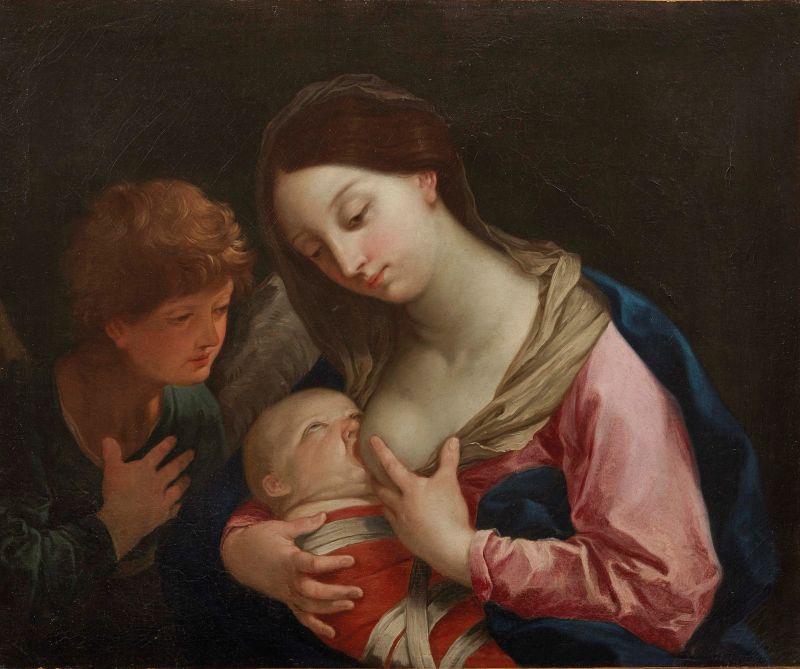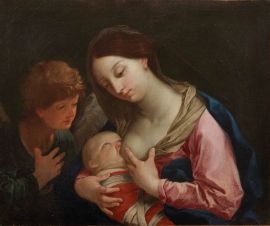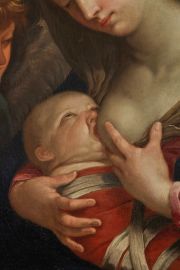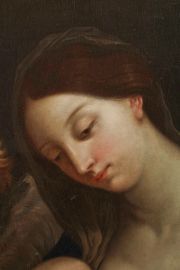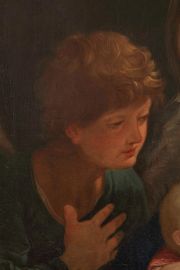Guido Reni
(Bologna, 1575 – 1642)VIRGIN AND CHILD, WITH AN ANGEL
oil on canvas, cm 62x74,5
in a gilded “Salvator Rosa” frame
An export licence is available for this lot
Coming from an old, aristocratic collection, still unexplored, this fine, unpublished work by Guido Reni is the autograph version of a painting documented, so far, through two ancient, little-known copies recording the subject and its composition, but far removed in quality from the original.
An 18th century copy in the collection of the Cassa Depositi e Prestiti, Rome (n. 32; oil on canvas, cm 75x98; fig. 1) coming from the Monte di Pietà, has been catalogued in the late 19th century as from Guido Reni’s school. In the recent catalogue of the collection (La collezione d’arte della Cassa Depositi e Prestiti, Rome 2008, n. 113) Vittorio Casale described this painting as a copy after a lost original of the Bolognese artist. A second, unpublished version, formerly in Prince del Drago collection, Rome, is documented thanks to a photograph in the Fototeca Federico Zeri, Bologna (fig. 2). It has an oval shape and seems superior in quality to the Cassa Depositi e Prestiti painting, but inferior to ours.
This specific subject – the Virgin feeding the Child – seldom appears in 17th and 18thcentury inventories documenting Reni’s works in Italian collections, which certifies its exceptional position in his catalogue. Only one painting from the collection of the Roman banker Paolo Falconieri catalogued in 1704 actually corresponds to our subject; it is described as oval in shape, and would thus appear to match the del Drago version rather than our painting: “Una Madonna ovata di Guido Reno (sic) in tela, cioè la Madonna il Bambino che zinna e un Angelo, con cornice dorata e intagliata”. (“An oval Virgin by Guido Reni on canvas, i.e. the Virgin with the suckling Child and an Angel in a gilded frame”).
As a sophisticated and knowledgeable collector, Paolo Falconieri held in very high place his painting by Guido Reni, and advised his heirs to keep it in the family: it was in fact included in the Nota di quadri… che desidero restino invenduti per lustro della famiglia… (List of the paintings which I do not want to be sold and should remain in the Family for its honour) (cfr. Dalma Frascarelli, “Per lustro della famiglia”: la nuova collezione di Paolo Falconieri 1634 – 1704, in “Rivista d’arte” 2011, pp. 205-253).
Different versions of this subject, quite exceptional in the artist’s catalogue, are the Virgin and Child in Raleigh, North Carolina Museum of Art (fig. 3), where the Virgin’s face is similar to ours, but the mother-and-child group stands out against fully Baroque draperies, and the so-called Madonna Tanari, a lost painting formerly in Bologna, currently known thanks to an etching by Mauro Gandolfi. In the latter, the Virgin appears in full figure with St. John the Baptist standing at her side; her draperies are similar to ours, as seen in a preparatory drawing for her left arm in Milan, Brera (n. 166; fig. 5).
Even the Christ Child in our painting is rather unusual in Reni’s work, as the artist generally represents him as a toddler, but somehow conscious of his divine nature.
In our painting, he is just a newborn suckling, falling asleep after his feed but still searching his mother’s face with half-closed, contented eyes. The red cloth covering him is held in place by bandages, according to an ancient custom, as can be seen in Reni’s Flight into Egypt in the Gerolamini, Naples. On the left, the angel who leans out looking at the Child might be an elder brother, possibly jealous for being left out of the mother-and child-embrace.
Overall, an intimate painting for private devotion: we might suppose it was commissioned to the artist by an aristocratic or a bourgeois family celebrating a longed-for newborn child.
Its very informality and simplicity of design sets off Guido’s sophisticated technique in the use of the dominant colour, a pink hue subtly graduating from near orange to cyclamen, hardly appearing over the cheeks and earlobe of the Virgin but strengthening over her hands, in the shade. Silver brushstrokes outline her veil and highlight folds in her sleeve and close to her blue cloak.
All works comparable to our painting come from the late Twenties or early Thirties, when Guido Reni, acknowledged as the “prince of painters”, was at the highest point of his career and his reputation. We can also cite for comparison the Virgin from the Annunciation in the altarpiece in the Pinacoteca of Ascoli Piceno, close to our Madonna in face and draperies, and the Virgin with the sleeping Child in Bologna, San Bartolomeo (fig. 4), from the early Thirties, and the Circumcision altarpiece, now in the Louvre: the young boy looking at the doves in the foreground, in his green dress and unruly hair is quite similar to the angel in our painting.
We are extremely grateful to Professor Daniele Benati who inspected this work in the flesh and confirmed the traditional attribution to Guido Reni.
.

